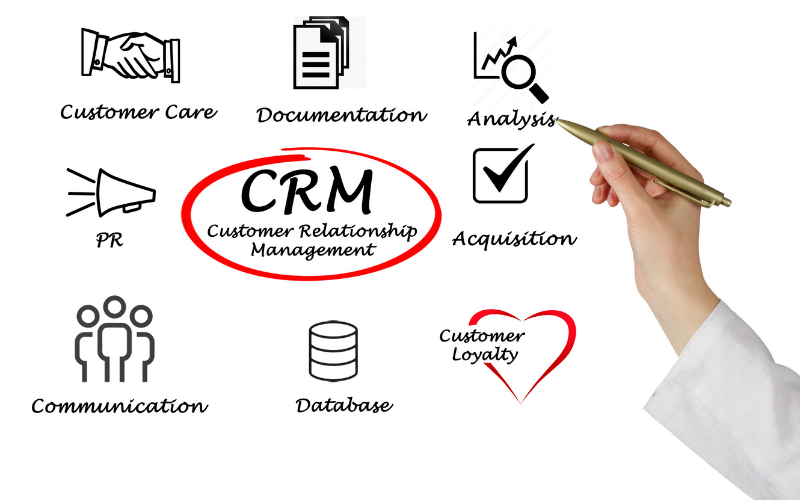Best and Worst Sales Approaches – Part 1 – The initial approach(es)
paul lloyd • March 14, 2022
In my 30+ years in the Sales Industry I’ve seen a LOT of change; I am a consultant in the IT Managed Service Provider (MSP) industry and as such technology is at the core of what I do. Sales targets are selected in an increasingly sophisticated manner, making it far far easier to reach the right people at the right time with the right product.
Yet it can still be so difficult to sell, even with all the right conditions and tech automation.
I’m going to look at this as a bit of an ongoing series, in which I attempt to analyse and critique the best and worst sales approaches I encounter in my personal and professional life and share some thoughts and insights to assist people in fine-tuning their sales performances.
Firstly, below is an email I received after I downloaded some content from the Salesforce website.
I considered this a great example of a good approach;
--------------------------------------------------------
Hi Paul,
After seeing you viewed some content on our site, I’m curious – what brings you to Salesforce?
I see you were looking at our marketing solutions, Other customers are interested in looking at our marketing automation tools because they experience one or many of the following challenges with their current solution:
·
Want unified CRM (Sales, Marketing, Service) experienced
Current platform is difficult to use
Needed features aren’t included
Aren’t happy with customer support
Sales and Marketing are working in silos
It would be great to connect for ten minutes to discuss your current priorities so that I can point you in the right direction.
What’s the best time for ten minutes today?
-------------------------------------------------------------
Why is this a good first contact email?
1. It’s polite
2. It respects my time
3. It’s short and to the point
4. It doesn’t push me to do / buy anything i.e., no instant Calendly / scheduler link
5. It gives me “business reasons” why I might be interested in their products, not solely focussing on their product to engage my interest.
And this is an example of one of the worst I’ve seen recently;
------------------------------------------------
Hello Paul,
My name is NAME. We, at CRM, have just received a demo request from you.
We offer an all-in-one CRM, which includes membership & event management modules, email marketing and speed networking tools, online payments, and mobile apps.
Could you please, in few sentences, let me know what are you looking for in terms of functionality?
Best regards,
----------------------------------------------
Why is this a bad first contact email?
1. I didn’t request a demo…
2. It talks solely about the product and not the reasons why I might need it
3. It asks me to do all the work in writing out my CRM requirements, and in just a few sentences...
4. The short snappy approach might work in some cases but not here as a first approach.
So here are some Best Practise tips I feel every good Salesperson should know;
1. Do your research
into the person and company you are approaching – Linked In has so much quality information. And it shows when people have looked you up and know how to approach you.
2. Use a mix of sales approaches
– combine phone and digital communications methods. All of these should be individually tailored for each prospect, and you should also be appreciative of people’s time. It’s ok to chase, but not hassle.
For example;
• Lookup/research prospect on Linked In / Google
• Send an intro email or Connect via Linked in with a brief but relevant message
• Follow-up with a call
• Then send another email saying you called on x date about x and invite them to book a call at their convenience via a scheduling tool – point out the business reason
• And for warmer prospects, the people you’ve engaged with previously, I’d add on a mix of voicemail and text messages to the above if appropriate.
• Also, in addition to the above do consider approaching via social media offering advice and insights and sharing your own case studies
3. Give clear reasons why to engage/choose
– you discuss the benefits to the prospect primarily, that your product can offer them and how it’s relevant. THEN you can segue into discussing your product and how it differs/is better than x competitors.
4. Don’t underestimate the power of a phone call
– when you’ve introduced yourself in an initial contact via Linked In or email it’s ok to reach out with a quick, polite call. Sometimes people can appreciate a call as it’s less onus on them to take time out of their day to contact you back if they are interested. Digital contact is a great warm up but a phone call can really make all the difference at times. It’s also ok to be protective of your time, if someone is interested and has booked a call but keeps rescheduling / cancelling, it’s ok to ask something along the lines of “I can see you are having trouble clearing time for our call, does this perhaps mean this isn’t a priority for your company right now?” And then dependent on the response N/Y you either chat in a couple of weeks or you say “Ok, understood, I’ll diarise a follow up in x months and won’t bother you till then”.
5. People are busy and and everyone has their own preferred contact style,
it’s up to you to find the best mix of styles and approaches that suits them and you.
Sales is a process not an event, words I live by.
Thanks for reading,
Paul Lloyd, Sellerly.
MSP/ VAR Sales Problem Solver,
Sales Management Mentor
P.S Did you know I’m a passionate bee enthusiast and keeper? Here’s your bee fact of the month;
“Bees pollinate 1 in 3 mouthfuls we eat"

Have you ever lost a client without even knowing they were looking around? For even the most “on the ball” Salesperson this is probably a very real reality. You lose clients without knowing they were looking . Less than 4% of your customers will tell you if they are unhappy so you may never know if you have a customer on the fence. There is something very British about not complaining about poor service, so here we take a look at the r easons why your customers may leave and change to another competitor.

Stages 3 - 4 - Beginning to Scale Up to Scaling Out So, in the last article, we looked at the two “starter” stages for a Sales business when it becomes successful and starts growing. Now we look at the pivotal maturing stages entitled loosely Beginnings of Scaling and Scale-Out. These stages occur when a f ew key things are met/achieved , usually, the business has an increasing number of teams and key sales roles in the organisation, 3-10+ Account Executives, multiple Sales Reps, and a growing Management team . Have a look below at the infographic and see where your organisation is measuring up. Where do you fit? How Sales Mature and Excellent are you / your organisation?

Stages 1 -2 - From a Founder Seller to a Small Sales Team So, congratulations, your Sales business is successful and growing, but is it maturing? Sales planning, whether at a company, department, or team level, is necessary for hitting targets and providing a framework for the whole business to strive towards, but do you know where you are in your Sales Maturity? A sales skills maturity model helps you evaluate your current sales skills and identify the areas that need improvement. Everyone needs a plan in their life, and anyone in Sales DEFINITELY needs a plan so we’ve put together this Infographic that details out the stages and milestones an organisation n eeds to typically follow to progress to Sales Excellence and Maturity . It’s a lot of information so we’ve focussed this week on Stages 1 and 2 only – Founder Seller to Small Sales Team , and our next blog will focus on Stages 3 and 4 – Beginnings of Scaling Up and Scale Out. Where do you fit? How Sales Mature and Excellent are you / your organisation?

Where are those New Clients? Over recent years I have spent a lot of time meeting and working with Managed Service Providers / VARs, and when discussing the biggest challenges in their business, it always comes back to the same thing over and over. WINNING NEW CUSTOMERS. This is a challenge that seems to affect any company of any size , whether their turnover is £500k or £40m. They need to win new contracts and new customers. Most of these businesses have reached the level that they have through recommendations and referrals or in the case of the bigger ones some acquisitions as well, rarely it seems going out and actively generating an opportunity and a sale.

Every company needs to do a sales forecast, whether weekly, monthly, or quarterly. Sales forecasts are an essential requirement for all stakeholders. Forecasting is a fundamental tool for businesses to plan, strategize, and make informed decisions. It helps them estimate future revenue, set goals, make informed business decisions, manage inventory, and supply chain, and improve cash flow management A good forecast means no surprises in store, funds in the bank and stock in the warehouse . Healthy forecasts protect companies from tough competitive and market conditions and position them better to adapt, plan, and thrive in the present and future. Based on current industry data and research, it seems most Sales leaders lack confidence in their forecasts, as well as the expertise to improve them. Disorganised and non-formal forecasting processes are a likely culprit. 93% of sales leaders are unable to forecast revenue within 5% , even with two weeks left in the quarter. 67% of organizations lack a formalized approach to forecasting altogether. 80% of sales organisations DO NOT have a forecast accuracy of greater than 75% . 55% of sales leaders do not have high confidence in their forecasting accuracy. (Stats from CSO Insights and Gartner)

A Trusted Advisor in the MSP market space is aiming for a long-term relationship, not short-term gain, and not to be seen as just a vendor, or worse still, the IT guy! So surely all TSP/MSPs want to be seen as trusted advisors to their clients, with the obvious benefits of repeat business, referrals, and introductions to your client’s other professional advisors. You do not need to “sell” your products or expertise when you are the Trusted Advisor. But have you put the time and effort in to be able to understand their business and what they are looking to achieve? Are you a true Trusted Advisor?

What is Lead Gen? “Lead Generation”, or “Lead Gen” for short, is the process of identifying and cultivating potential customers for a business's products or services. It is essential for businesses as it can turn interested parties into paying customers which in turn helps to create a stable customer base and drive sales, this then creates an ongoing cycle where customers give good reviews, which in turn results in customer loyalty and new business from that. Lead Gen also allows for a better understanding of a company's key customers and target markets, their needs and preferences thus allowing for more personalisation of products, services and marketing communications.



